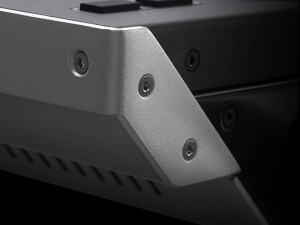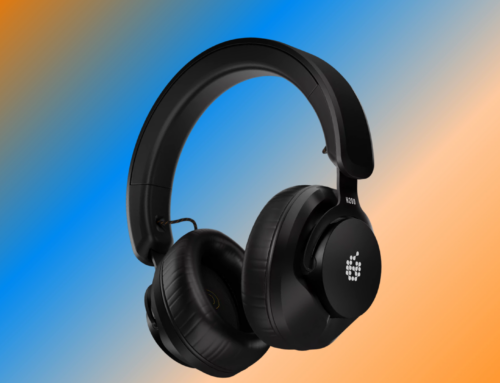Announced in January 2013, the Numark NS7II is supposedly the best controller ever built. While this statement can surely be contested (and debated, depending upon what you prefer for DJing), the NS7II certainly has a few major points going for it: one, comprehensiveness; two, quality; and three, something for everyone, including the turntablist and traditional DJ that still prefers the feel and sound of vinyl.
 On a physical level, the design is heavy – in fact, it’s made out of metal to handle extensive wear and tear and hold up to years of usage. Beyond this, the design continues to remain quality: real slip mats and vinyl, motorized platters, a full range of touch-activated knobs and filters, and velocity-sensitive performance pads that give excellent responsiveness. Design aside, Numark emphasizes the NS7II’s visual feedback, and it certainly goes above what you usually get from a controller or mixer. As well, users can expect high-resolution MIDI and complete integration with Serato.
On a physical level, the design is heavy – in fact, it’s made out of metal to handle extensive wear and tear and hold up to years of usage. Beyond this, the design continues to remain quality: real slip mats and vinyl, motorized platters, a full range of touch-activated knobs and filters, and velocity-sensitive performance pads that give excellent responsiveness. Design aside, Numark emphasizes the NS7II’s visual feedback, and it certainly goes above what you usually get from a controller or mixer. As well, users can expect high-resolution MIDI and complete integration with Serato.
Before we touch on the full range of uses and Serato integration, you’ve got to first understand all the NS7II’s functions. This four-channel mixer offers the option of standalone operation or using up to four external sources without even needing a computer. What can you add? CD players, turntables, MP3 players, and pretty much any standard device you’d ordinarily use.
Statements from the brand further push the Akai Professional MPC pads, which are a step up from what a mixer or controller usually offers. With a multi-color display, these 16 velocity-sensitive pads let the user quickly change between 10 modes with 10 buttons for loop, cue, roll, sample, and slice functions. Letting the user know just what is happening, the pads light up with an RGB display instantly without delay, while the color distinctly lets you know which mode you’re using.
 The MPC pads, however, are just the first in a long line of responsive, quality features that let you do professional mixes spontaneously. Touch-sensitive EQ knobs, hot cue buttons, and Strip Search technology give access to effects and filters – of which there are three modes for each. Like the pads, these too respond instantly to the touch.
The MPC pads, however, are just the first in a long line of responsive, quality features that let you do professional mixes spontaneously. Touch-sensitive EQ knobs, hot cue buttons, and Strip Search technology give access to effects and filters – of which there are three modes for each. Like the pads, these too respond instantly to the touch.
 Although an intuitive design and instant responsiveness are certainly bonuses, what makes the NS7II is the ease of usage: Rather than involve something complex, all that’s required is touching the knob to add an effect to your mix, and turning it to adjust it. In total, the DJ has access to 12 isotope effects, with two effects banks per channel and three effects per bank. Six effects, as a result, can be used simultaneously on any channel.
Although an intuitive design and instant responsiveness are certainly bonuses, what makes the NS7II is the ease of usage: Rather than involve something complex, all that’s required is touching the knob to add an effect to your mix, and turning it to adjust it. In total, the DJ has access to 12 isotope effects, with two effects banks per channel and three effects per bank. Six effects, as a result, can be used simultaneously on any channel.
 Out of all possibilities, a few effects stand out. The Filter Roll controls a high/low-pass filter alongside a roll. When the DJ turns the knob, the intensity of both aspects increases. As well, instant frequency kills, on all four channels, give the DJ quick on/off control. Third, the Filter FX button allows the user to activate a filter effect of his choice; with the knob controlling high/low-pass filter and the effect, two parts of your mix can increase and decrease together. As well, the Master FX buttons apply an effect across all channels.
Out of all possibilities, a few effects stand out. The Filter Roll controls a high/low-pass filter alongside a roll. When the DJ turns the knob, the intensity of both aspects increases. As well, instant frequency kills, on all four channels, give the DJ quick on/off control. Third, the Filter FX button allows the user to activate a filter effect of his choice; with the knob controlling high/low-pass filter and the effect, two parts of your mix can increase and decrease together. As well, the Master FX buttons apply an effect across all channels.
 Although the effects and filter capabilities make the NS7II a standout, the features start where the NS7 left off and get better. Users get access to a reliable BPM meter, which makes beat-matching extremely clear; an easy-to-use and exact CP-Pro crossfader; dedicated controls through the Bleep-Reverse Switch; a dedicated channel for the mic input, allowing all channels for mixing to be open; improved Strip Search, which tells you the track’s precise point; Beat Grid buttons for full and accurate control of all effects; two large shift buttons to get to a second level of controls; and Slip Mode, for improved control as you change records or scratch.
Although the effects and filter capabilities make the NS7II a standout, the features start where the NS7 left off and get better. Users get access to a reliable BPM meter, which makes beat-matching extremely clear; an easy-to-use and exact CP-Pro crossfader; dedicated controls through the Bleep-Reverse Switch; a dedicated channel for the mic input, allowing all channels for mixing to be open; improved Strip Search, which tells you the track’s precise point; Beat Grid buttons for full and accurate control of all effects; two large shift buttons to get to a second level of controls; and Slip Mode, for improved control as you change records or scratch.
 While many of the features and capabilities exceed what you get with a typical controller, what puts the NS7II in a brand new category is the versatility. As much as the turntable vs. CDJ vs. controller vs. iPad debate continues to go on (and on and on), Numark looks to be creating a middle ground, essentially showing that it’s not what you DJ with but how you do it. That being said, how does it stack up for vinyl? Beyond its standard aspects, the platters are actually motorized, with a choice of high and low torque settings, and are supposed by ultra-high resolution MIDI (3,600 ticks per rotation). What this gives the user is a near-authentic mixing experience similar to that with analog platters but with quick access to and efficient use of a digital music library.
While many of the features and capabilities exceed what you get with a typical controller, what puts the NS7II in a brand new category is the versatility. As much as the turntable vs. CDJ vs. controller vs. iPad debate continues to go on (and on and on), Numark looks to be creating a middle ground, essentially showing that it’s not what you DJ with but how you do it. That being said, how does it stack up for vinyl? Beyond its standard aspects, the platters are actually motorized, with a choice of high and low torque settings, and are supposed by ultra-high resolution MIDI (3,600 ticks per rotation). What this gives the user is a near-authentic mixing experience similar to that with analog platters but with quick access to and efficient use of a digital music library.
 With all of these plus points, the NS7II has one downside: no Traktor support. While this is certainly a deal-breaker for many DJs, it seamlessly works with Serato, offering the full range of tools, hardware, and control.
With all of these plus points, the NS7II has one downside: no Traktor support. While this is certainly a deal-breaker for many DJs, it seamlessly works with Serato, offering the full range of tools, hardware, and control.
The NS7II may be too new to the market to call it “the best,” but for the DJ comfortable with Serato, who wants a full range of features on a strong mixer, and who wants to effortlessly mix from sources as divergent as vinyl and digital music files, this device matches just what you’ve been looking for.




